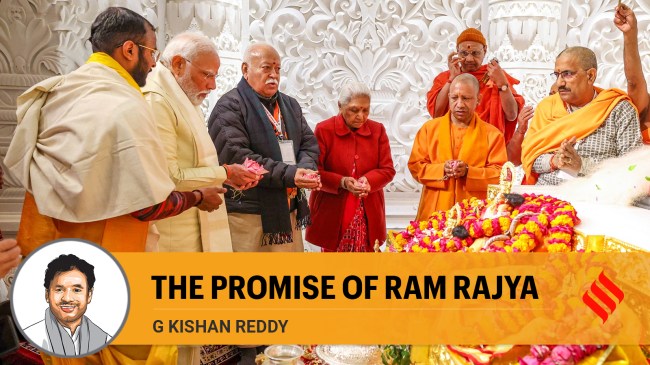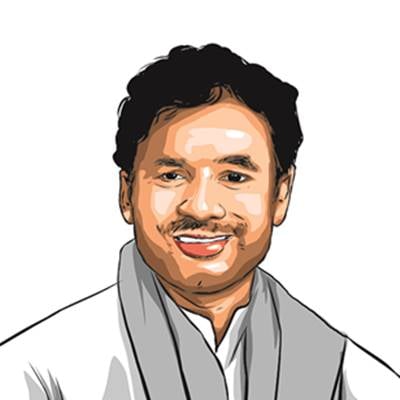Opinion As Lord Rama returns to Ayodhya we will see a stronger, more confident India
Moments such as the restoration of the temple for Lord Rama in Ayodhya are epochal events that alter the very journey of nations and their people. This is the true promise of Ram Rajya
 Prime Minister Narendra Modi with Uttar Pradesh Governor Anandiben Patel and Chief Minister Yogi Adityanath, and Rashtriya Swayamsevak Sangh (RSS) chief Mohan Bhagwat during the Pran Pratishtha ceremony at the Ram Mandir in Ayodhya. (PTI)
Prime Minister Narendra Modi with Uttar Pradesh Governor Anandiben Patel and Chief Minister Yogi Adityanath, and Rashtriya Swayamsevak Sangh (RSS) chief Mohan Bhagwat during the Pran Pratishtha ceremony at the Ram Mandir in Ayodhya. (PTI) On January 22, 2024, Prime Minister Narendra Modi performed the pran pratishtha ceremony for the Ram mandir under the guidance of distinguished pandits and vedic Brahmins at Ram Janmabhoomi in Ayodhya. As the Prime Minister performed the first aarti of Lord Ram, many devotees across the world prayed either at local temples or from their homes. This spontaneous outpouring was not just because this was a matter of pride for all Sanatanis, but also because Hindus across the world secured the right to build a temple for Lord Ram constitutionally, after waiting for an agonising 500 years.
The wait has not been without its hardships and tribulations. For generations, individual and community memories have surfaced and come together as collective anguish. Take the case of Ayodhya’s Suryavanshi Kshatriyas who are considered to be the descendants of Lord Ram. It was the Suryavanshi Kshatriyas led by Raja Gajraj Singh who offered stiff resistance to Babur’s army led by General Mir Baqi, when Ayodhya was seized and the mosque built. The Suryavanshis of Ayodhya vowed to not cover their heads with the ceremonial turban till the temple at Ayodhya was restored. Some even shunned footwear. After many generations, the Suryavanshis of Ayodhya are once again donning turbans today. Other faiths have contributed to the reclaiming of the temple and are now joining in the celebrations as well. The Sikh founding Guru, Sri Guru Nanak Dev is said to have visited the Ram temple in 1510 and the Supreme Court considered this as key evidence in its 2019 judgement. In the run-up to the pran pratishtha, the “Akhand Path” that involves the continuous recitation of the Guru Granth Sahib for 48 hours was also observed.
Across India, from Kutch in the west to Kohima in the east, from Kashmir in the north to Kanyakumari in the South, communities are celebrating in their own way, just as they recorded the 500 year wait in their own unique way. Several communities worldwide too are cherishing this moment. From Korea and Cambodia in the Eastern Hemisphere to the island nations of Antigua and Barbuda, people are celebrating this momentous occasion.
These celebrations are anchored around the rejuvenation of our civilisational heritage. Hence, the decision of some to not participate in this sacred ceremony is regrettable. This refusal to share the joy of the people on the ground primarily arises from a mindset of minority appeasement. In order to placate and polarise some minority communities and treat them as vote banks, a select few are willing to go to any levels. This included the boycott of a momentous occasion such as the pran pratishtha ceremony. This tendency to look at everything related to Sanatan Dharma through a deeply skewed political prism shows an utter lack of civilisational pride. Those who issued these boycotts refuse to acknowledge the role of Hinduism and the Hindu way of life in binding this great and diverse nation.
One such periodic offender is the Congress Party. Congress has a known history of being ashamed of India’s civilisational past and looks at Hindus and Hinduism with complete disdain. For example, in November 1947, Sardar Patel wanted to reconstruct the Somnath Temple. This was also favoured by Mahatma Gandhi. At that juncture, Prime Minister Jawaharlal Nehru vehemently opposed the move. In May 1951, he wrote several letters to President Rajendra Prasad to dissuade him from participating in the pran pratishtha of Somnath Temple. When President Rajendra Prasad wanted to collect water and twigs from other countries to consecrate the temple, he termed it as rash. In the notes to the Foreign Secretary and others in the embassies abroad, Pandit Nehru termed it as fanciful and instructed embassies to not entertain such requests.
Similarly, in September 2007, in an affidavit submitted to the Supreme Court, the Congress government wanted to dismantle the Ram Setu to build the Sethusamudram shipping canal project. In an affidavit filed in the Supreme Court it stated that “mythological texts, which formed an important part of ancient Indian literature cannot be said to be historical records to incontrovertibly prove the existence of the characters or the occurrence of the event”.
In a way the run-up to the pran pratishtha at Ayodhya is a replay of the events that took place in the run-up to the revival of Somnath just after India attained her independence. Even then the Congress party was totally uncomfortable with our civilisational heritage and mixed this with a bizarre political calculation of shunning the moment thinking it will endear itself to the minority population. This twisted thinking is an insult to the minorities of this nation. A live example of this playing out poorly is the Shah Bano incident in the mid-1980s. The Supreme Court of India decided that Shah Bano, a divorced muslim woman, be paid maintenance by her husband. The government led by former Prime Minister Rajiv Gandhi diluted the judgement by enacting a law. Till today, this single incident has led to the continued marginalisation of the rights of Muslim women.
Moments such as the restoration of the temple for Lord Ram in Ayodhya are epochal events that alter the very journey of nations and their people. This will indeed go down in our collective history as a pivotal moment in civilisational awakening. As Lord Ram returns to Ayodhya, we will see a stronger, more confident India that works for the welfare and upliftment of everyone of her citizens. This is the true promise of Ram Rajya.
The writer is the Union Minister of Culture, Tourism and DoNER. He represents Secunderabad Lok Sabha constituency






